We were very excited to have BJ Lackland, CEO of Lighter Capital, take the stage and moderate this talk by Auren Hoffman, former CEO and co-founder of LiveRamp. As a serial founder with five successful exits, Auren (who you may already know from his prolific Quora posts), has a tremendous amount of time-tested advice on how to start and scale a business.
Auren has an affinity for challenging the status quo and shares multiple examples of going against the grain has led to his success and why he thinks it will bring other founders success too. If you want to learn about hiring the right salespeople, when to refuse business, the reality of the abundance of enterprise software companies, and more, this is a session you won’t want to miss.
Check out the full transcript below! You can view the slides here.
If you want to see more sessions from 2016, we’re releasing a new one each week. Subscribe here to be notified. And be sure to grab your tickets to the 2017 Annual NOW.
TRANSCRIPT
BJ Lackland: Next up we’ve got Auren Hoffman, who is the co-founder and former CEO of LiveRamp, the largest middleware provider for our marketing automation companies.
Kind of keeping along with the theme that Leo had, on lessons and such, Auren’s going to talk a lot about five different lessons he learned that he’s doing much better this time. I’m really excited to sort of keep in this theme of lessons that founders have.
With Auren, we’ve really got a repeat founder of businesses, who’s successfully then exited. It’s that time to put down some great thoughts on what to do better next time. With that, I’d like to welcome Auren.
Auren Hoffman: Thanks.
BJ: Welcome.
Auren: We are going to have a good conversation here today. I’m going to try to do these slides very quickly and leave as much time as possible for questions. Your assignment is to think of a good question. If you are really an entrepreneur you’ll have a good one.
Then we can have a little bit of a discussion going forward as we move forward together. Just quickly we are going to talk about is basically five core lessons that I learned from LiveRamp, and then what we are doing from those lessons in the new company I’m involved with, Siftery.
Just a quick overview, LiveRamp is the largest middleware company in marketing technology. If you are in the marketing technology space you’ve probably have heard of LiveRamp. If you are not, you almost certainly have not heard of LiveRamp.
Siftery is a new company. Siftery helps companies find products, tools that they should be using, different software products. If you are selling a software product, your software product’s almost certainly listed already on Siftery, etc. Just to give you a quick overview of those two things.
Before I go forward just a quick poll, how many people here when you start a company is trying to enter a market bigger than a billion dollars? We are going to talk about that. Then in this debate of hiring there’s always this debate between going for experience over going for potential.
How many people here go for experience? Raise your hand if you are experience people? We have two people, really, OK, three, four. How many are potential? How many of you are just really tired right now? Awesome, great.
We are going to talk about basically five core lessons. The first lesson is all-around athletes beat position players, at least in the early days. Second lesson is put yourself in a box to define optionality. The third lesson is focus on a small market that you can actually win.
The fourth lesson is about sales people, about the product-oriented sales people versus relationship-oriented sales people. The fifth lesson is basically about the future of enterprise software, which we’ll have a discussion about as well. That makes sense?
That’s our quick journey basically, five lessons, five slides. The first lesson is basically again you have these all-around athletes which are basically people with potential versus the position players, which are the people with experience.
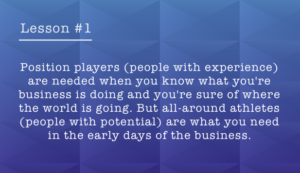 If you know what you are going to do and you are very sure where the world is going, almost always position players beat all round athletes. If you know you are going to be playing football in the Super Bowl, you need a kicker who can kick field goals.
If you know what you are going to do and you are very sure where the world is going, almost always position players beat all round athletes. If you know you are going to be playing football in the Super Bowl, you need a kicker who can kick field goals.
You need to have one of the best kickers in the world, otherwise you aren’t going to the Super Bowl. If you don’t know what sport you are going to play, you might be playing the decathlon, maybe the person who can only kick field goals might not be the person you should be getting on your team.
In the early days essentially our core thesis is all-around athletes are better than position players. People with potential are better than experience. That was our core learning at LiveRamp. Almost every single person at LiveRamp was hired with less than five years of experience.
Almost every single person we ever hired out of like the 200 people hired at LiveRamp was hired with less than five years experience. As we grew we promoted those people to manage. The person who took my job over and is now running the company we hired out of college.
He’s now running the 200-person company today. When you scale and you know what you are doing then bringing those position players can be sometimes really helpful. Now this is pretty controversial, so hopefully we can have some questions about this as we go forward.
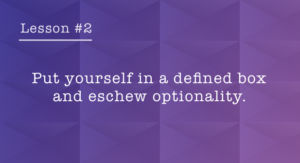 Second thing is to put yourself in a box. Again this is pretty controversial. Most people don’t agree with me here. My core thing is to be as focused as possible, to put yourself in a box, and the box basically says what you are not going to do.
Second thing is to put yourself in a box. Again this is pretty controversial. Most people don’t agree with me here. My core thing is to be as focused as possible, to put yourself in a box, and the box basically says what you are not going to do.
I think you should publicly state to everyone who will listen, that includes your customers, your partners, your employees, your investors, anytime you talk publicly about your company this is what we don’t do. We are not going to do all these things. We are just going to do this tiny little thing.
We are only going to do this thing. Here’s where we are going to go and we are putting ourselves in a very defined box. Almost every smart person in the world will disagree with me. They’ll say, “No, you need to leave your options open. You need to be able to do all these things. You don’t know where the world is going to take you.”
I think you can be smart enough to know where the world is going and put yourself in a box and really, really, really own that particular box. At LiveRamp people would say, “Are you going to do media?” We say, “We are never going to do media.” “Are you going to build applications?” No, we are never going to build applications.
We are just middleware company. We are just going to move data between one application to another. Today that’s still all LiveRamp does all these years later. It doesn’t do anything else. It just basically moves data between applications.
“Do you actually do anything with the data?” No, we just move data between the applications. We only do that. We’ll never do anything else. That’s the only thing we are going to do. If you do that, if you eschew optionality and you stay focused then it’s really easy for all your employees to make decisions.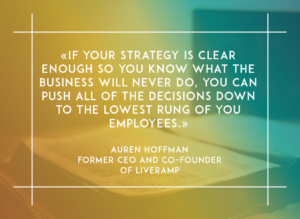
If the strategy is clear of what you’ll never do, you can push all of decisions down to the lowest rung of your employees. If the strategy isn’t clear you need to micromanage your employees a lot more. You need to be involved with a lot more of the decision making.
Almost every strategic deal that has to be done by one of the three strategic people in your company, because not everyone will know enough to know what’s going on. The clearer you can make the strategy of what you will or will not do the easier it is to push that down.
At Siftery we are doing the same thing. Siftery the first thing people ask us if you go to the siftery.com site is, “Great, I’m vendor. I want to pay you.” We are never going to take money from vendors, sorry. We are going to try to build tools for buyers and not for vendors.
Yes, people constantly are asking us, “Great, you can build on this price. You can get all this money.” Being publicly out there of not doing something allows a lot more clarity from the entire organization to go forward. I hope that makes sense. That’s two. Three. Again this is also pretty controversial.
If you are starting a company or you are starting a new product in your company, my advice is to find the smallest market that you could go after. Find the tiniest, tiniest market and go after that market and own that market. Now the best market has three basic core things that you want to look for.
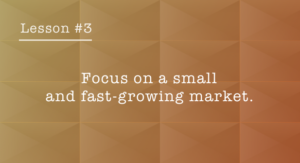 One is that it’s really, really small and we’ll talk about why in a second. The second is that you can own it, so that you will be the dominant player. Hopefully you’ll own over 50 percent market share. The third is that the market is going to grow really, really, really fast. That’s the three most best things to go after.
One is that it’s really, really small and we’ll talk about why in a second. The second is that you can own it, so that you will be the dominant player. Hopefully you’ll own over 50 percent market share. The third is that the market is going to grow really, really, really fast. That’s the three most best things to go after.
The reason why you want to go after a small market is because no else is going to care about it and therefore you can own it. If you are going after a large market everyone else is going to care about that market. You want to go after the smallest market as possible.
When LiveRamp started our first year in business, 2011, first year with our product, our total market for what we were doing was three million dollars. Three million dollars was the total market. We had two competitors out there.
We did a million, first year of revenue, and we had two other competitors that were out there. Those competitors both were part of companies that had over 100 million in revenue, and they didn’t really care about this market.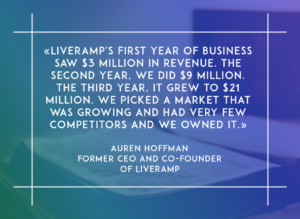
They weren’t going to fight hard to make that market win. Second year of LiveRamp revenue we did nine million in revenue, nine million in SaaS revenue. We did more in revenue second year than the entire market was the first year, because we picked a market that was growing.
We picked a market we could find that was growing. Third year revenue LiveRamp we did 21 million in revenue and we were profitable. That’s super fast growth for a profitable company. You almost never see a SaaS company grow that fast when it’s profitable.
The reason is we own the market. It was much easier to be profitable. We own the market, our sales expenses were really, really tiny. We did 21 million of revenue with five sales people, because we own the market.
It’s like, “If you want,” it’s just like it’s pretty easy to sell. We either we could sell it you or not. Like if you needed it or not. We were the market leader. We had the best product in market. Nobody else really cared enough about that market to really focus on that market.
Now that was 2013, numbers since are somewhat public, because we are part of a public company. It’s still one of the fastest growing SaaS companies of its size that’s around and really because it owns the market. Siftery’s goal is to be similar. It’s to really try to own that market as well.
Fourth thing, and this is also going to be controversial. There’s basically two types of salespeople that are out there. There’s product-oriented sales people and there’s relationship-oriented sales people.
You need to figure out what type of company you are and you need to figure that out fast, because it’s really going to change the type of salespeople you need. Relationship-oriented sales people are the typical sales person that you find.
They are gregarious. They are outgoing. They are extroverted. They are your friend. They are buying drinks for everyone. They are going to talk to you when they are on the airplane. They are going to trade information. They are the life of the party. They’re going to tell jokes. That’s the relationship-oriented sales person.
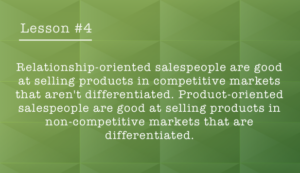 If you’re selling a product which has a lot of competition and is not as differentiated, be honest with yourself if you are, that relationship salesperson is going to be really helpful. They’re going to build really good relationships with the customer, and they’re going to actually get that sale going.
If you’re selling a product which has a lot of competition and is not as differentiated, be honest with yourself if you are, that relationship salesperson is going to be really helpful. They’re going to build really good relationships with the customer, and they’re going to actually get that sale going.
The product-oriented sales person is introverted. They look at their shoes. They’re not the life of the party. When the cocktail hour comes, they actually go to their hotel room and shoot off, like, 50 emails. Now, they’re just as competitive as the relationship-oriented sales person, but they’re much more into the weeds of the product.
Product-oriented salespeople usually don’t have a sales engineer. They’re actually the sales engineer themselves. They’re much more technical. They’re much more involved. If you have a product that is really differentiated.
If you have a product that is really different, and, again, you’ve got to be honest with yourself, then you want the product-oriented sales person. The product-oriented sales person is never taking someone to the baseball game. Never.
They’re just going out there, and they’re explaining the product, they’re patient with the customer. They’re working with the customer to help that customer understand what they do and understand the capabilities.
Then, they’re really making the decision up to the customer of whether or not they should buy this product, because it’s differentiated. Their main goals, they’re trying to get the customer to understand the true capabilities of the product, not the razzle dazzle, “Here’s just what we do.”
You have to be very smart and technical, because you have to answer a lot of questions and be patient as the customer gets up the learning curve. At LiveRamp, every one of our salespeople, all of our top salespeople, are product-oriented salespeople.
They’re all introverted. Our tops sales person who runs the sales team, his first job out of college was a chip designer at AMD. He’s an electrical engineer. He’s incredibly successful building out with these more introverted salespeople.
My number one mistake as a founder was hiring extroverted salespeople to sell a product-oriented product. We’ll see if this thing works. There we go. Perfect. The last thing we’ll talk about today is the future of enterprise software.
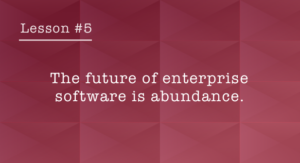 Why are you all here at SaaStr? You’re all here at SaaStr because there’s just this massive abundance of enterprise software. Almost all of you are at an enterprise software company or you’re probably somebody who invests in enterprise software companies. That would probably represent 98 percent of this room.
Why are you all here at SaaStr? You’re all here at SaaStr because there’s just this massive abundance of enterprise software. Almost all of you are at an enterprise software company or you’re probably somebody who invests in enterprise software companies. That would probably represent 98 percent of this room.
You’re like, “Wow.” You look around the room, you’re like, “There are a lot of enterprise software companies in this world,” and there are. The number of enterprise software companies has gone up 20X in the last 10 years.
The number of software companies that the average company buys, let’s say a company like Best Buy, the average company like Best Buy buys, has gone up 10X in the last 10 years. A company like Best Buy had about maybe 45 vendors or so 10 years ago. Today, they have about 450 vendors.
The number of buyers within an enterprise software company has gone up 12X. There used to be a small number of people that buy software. Now, there’s a huge number of people within the company that are buying software or influencing the buying of that software.
The budgets have gone up dramatically, as well, over the last 10 years. The budget for software within most of these big companies has gone up like this. The budget for people, for employees, has been flat the last 10 years of large companies.
They’re making a conscious choice to replace people with APIs, people with software. Essentially, they’re using your companies for people, and this is happening everywhere. You have to think about how do I play into this market of abundance, this abundance that’s coming out there?
Which side am I on? Am I on the side where I’m going to have just massive competition? I think that’s OK, as long as you’ve got something very differentiated, because people will buy.
It used to be that if somebody bought SAP and SAP had a feature that they were essentially getting for free because they already bought SAP which was worse than your company’s product, they’ll still stay with SAP. They won’t use your product.
Today, if your product is better than the free one they’re getting from SAP, they’re buying your product. They’re used to doing that, and it’s so much easier to sell into companies today. It’s OK, but you will have more competition.
Are you playing on the other side of it like the middleware companies, LiveRamp, SnapLogic, MuleSoft, Clever, Segment, etc., all these middleware companies? SaaStr. SaaSter, essentially, is a middleware company.
It’s basically a conference that’s bringing all these vendors together. They’re allowing a talk to each other. They’re like a human middleware company is what SaaStr is right here. SaaStr plays into this global trend.
That’s what we’re trying to do with Siftery, as well. Siftery is really helping companies learn about all this different software that’s out there, and it’s trying to play into this trend. In some ways, you’re going to be affected by this trend.
It’s becoming much easier to buy software, so many of you, your sales are going to be much easier than it was before. It’s much easier to start these companies. There’s lots more competition in every given space, so we’re all going to play into this trend.
Now, with that, we’re going to use your homework that we gave to you. You can tweet at me, or you can Quora me, or whatever else it might be. Hopefully we’ll get your questions, as well.
BJ: To open it up. Actually, I’ve got one to start. On your point about starting with a small market, at Lighter Capital, we fund a ton of SaaS companies, and a ton of companies focus on relatively niche markets. We see more, and more, and more. We’ve got maps of what different niche markets are coming up.
One thing I’d love to learn is how is it that you identify such a small market that’s growing quickly? It’s not like you can get a Gartner Report, because by the time Gartner’s come out and made a report about a fast-growing market, it’s four billion dollars. How is it you’ve identified that kind of stuff?
I think there are a lot of people that are thinking about founding companies that want to find a place to go, but how do you identify that would be a great lesson, I think.
Auren: That’s the $25 billion question, right? It’s a really, really good question, and it’s a really, really hard thing to do. If Gartner’s writing a report on it, first of all, Gartner has never, in the history, wrote a report where it didn’t have multiple companies in the…
[crosstalk]
Auren: It’s already writing a report about something that’s fairly competitive that’s out there. Usually, it means you have to have some sort of proprietary knowledge. You have to understand this space better than others. If you’re old like me, this is where old guys like me have an advantage.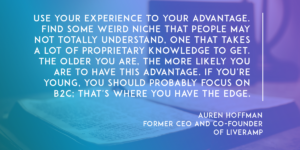
If you’re old like me, I’m on the old side of the tech world, this is where you want to be. You want to be in a place where you can use your experience. If you’re young, you should probably be doing a B2C type of thing. That’s where you have the edge.
Use your experience to your advantage. It doesn’t have that many advantages when you’re old, but if you have a little bit of gray hair, use your experience to your advantage. Find some weird niche that maybe people don’t totally understand. Maybe it takes a lot of proprietary knowledge to get.
There’s some weird thing in the insurance world about how the claims get moved around, and there’s all this government regulation, but you know it because you were in it for a while and your brother-in-law’s got a company, or whatever it might be, and then do it. If I knew exactly how to find it, I would be starting these companies every day.
BJ: No, I totally agree. We see that a lot because we fund a lot of smaller, niche SaaS companies like that. I’m always impressed when they’ve really focused on something small.
I think that one of the challenges that’s come up that would also be interesting from that is going on to raise equity when you’re focused on something small. Because a lot of VCs really want a, at Lighter Capital we’re not a traditional VC, so we’re not focused on this, but they really want to see that you have a big market.
You started your speech with, “Who here is addressing a billion dollar market?” because if you’re not addressing a billion dollar market, it might be hard to raise equity money. But if you start small and focused, I totally agree, you’ve got a better business in the long run, but it can be sometimes hard to sell that to investors. A big vision about a small market.
Auren: You’re absolutely right, raising money in a small market is really hard because by definition, if you’re going after a small market that you think is going to grow fast, most people won’t believe you that it’s going to grow fast, otherwise other people would already be in this market.
You have to convince these people that it will grow fast. VCs aren’t any smarter than anyone else here. It’s going to be very difficult to convince them. A lot of them will think the market’s going to tap out or etc.
My retort is if is someone says, “I know you’re going to get to $25 million in revenue, and that’s going to be great, but I really want to only invest in a company that can get to a billion in revenue,” my retort to them is, “Look at our team.”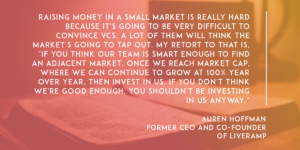
“If you think we’re smart enough, once we get to $25 million, to find an adjacent market where we can continue to grow at 100 percent year over year, then invest in us. If you don’t think we’re a good enough team, then you shouldn’t be investing in us.”
Put the pressure on them to say, “Look, if you don’t think we’re a good enough team, that’s fine. Then you probably shouldn’t invest in us anyway. But if you do, we’re probably smart enough to move to an adjacent market.”
BJ: It’s the old idea of, I guess this shows my age, “Crossing the Chasm.” The old Crossing the Chasm, for those that haven’t read that.
Auren: We’ve got two oldies up here.
BJ: Yeah, exactly. With that, I’ve hogged enough question time. Let’s have some questions from the audience. We got one for you.
Male Participant: Thank you. My question is relating. We’ve got three converting buyer personas, completely different niche markets. What you said, I believe, in slide two, we want to find one that we want to double down on and own that buyer persona’s market?
Auren: Definitely.
Male Participant: Does it make sense for us to put down our cards, and neglect the other two converting buyer personas, and just own the one that we see the most potential in? How do you typically approach that situation when you know you can make money on other segments?
Auren: Without knowing anything about your business and probably, likely, to be wrong, but my bias would be to immediately focus on the one thing that you think has the most potential or, for whatever reason, you’re going to do the best at, your product is the best fit for, and not worry about the other…
Publicly tell all your employees, “We’re not going to worry about these other guys. We’re not going to go after them. We’re just going to go after this persona. We’re going to own this persona. We’re going to build tools for this persona. I want you to dream about this persona at night, and we’re going to do everything possible to build things for this persona.”
BJ: We’ve got one back here. Back over here.
Male Participant: Following up on that question, if you go customers in other segments that actually came to you and say, “Hey, we want your product,” would you refuse the business?
Auren: Potentially. One of the other things in SaaS companies, the most important things in SaaS companies, is churn. In the end, basically, is customer satisfaction. Do customers love your product and are they going to stick with your product?
The LiveRamp numbers for last year aren’t public, but almost every year LiveRamp churn, our number of customers that left us, was under five percent of our customers left in the year. We had negative churn every year from a revenue standpoint.
You want to sell to people you know are going to benefit from it. When someone wants to buy it and you don’t believe they’re going to benefit from it as much as they should, you might be wrong. You might want to investigate, “OK, why do you want to buy it? What’s going on?”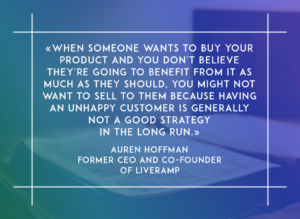
If you believe they’re not going to benefit from it as much as they should, having an unhappy customer in the long run is generally not a good strategy.
Male Participant: I may represent the engineers who started companies. I’m the CEO who’s an engineer. That means I’m product sales-oriented, correct? I’ve hired a VP of sales, my only salesperson who’s really relationship-oriented.
Does that make me the sales engineer, or am I driving it? Am I going to build a sales organization around product, or can there be a balance?
Auren: My personal feeling is it depends on the product that you’re building and who you’re selling it to. For instance, I come from the marketing technology world. In there it’s pretty easy to make the distinction.
In the marketing technology world if you sell products to agencies, you’re relationship. Almost 100 percent of companies that sell products to agencies, you need relationship salespeople. You need to be taking these agency people out to dinners and drinks.
You need to be building long-term relationships with these agencies. When you’re selling it actually to the marketers, like if you’re selling it directly to Coca Cola, and not to the agency, again, this is a simple heuristic, usually you need more the product-oriented sales team.
Because it’s got something that’s fairly differentiated and fairly different. You want to understand your company and you want to understand the type of company you have. Either you have the right head of sales or you don’t, depending on the type of product that you have.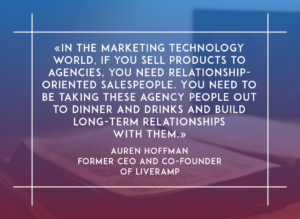
BJ: You’ve got one behind. Oops, sorry. That’s OK.
Male Participant: Great talk. What’s your tips for finding the high-potential candidates when you’re hiring them? Can you give us two highlights how you pick the people you’re going to hire?
Auren: That’s a really good question. First of all, hiring people is incredibly humbling. There’s probably no one here that has had a really great hit rate. One of the things that is even more humbling is, let’s say you hire 30 people.
You may have five that don’t work out, or 10, whatever it is, that don’t work out. You’ll also have these five superstars, let’s say, that end up becoming superstars. Those people are the people that really drive your organization.
In my personal experience I have never been able to pick out the superstars before they were superstars. I may have hired 40 people. Maybe they all turn out to be at least pretty good, very, very good employees, and they may all be A players, but there are four who are these absolute superstars.
I wasn’t smart enough to know before I hired them that they would be incredible people. Those are the people that really drive you. Of course, once you work with them it’s easy. Once you’ve worked with them before it’s really easy to know in the future.
This is a long-winded way of saying I have no freaking clue how to do it. If anyone here comes up with it, by the way, please tweet me or email me. I would love to know how to hire better.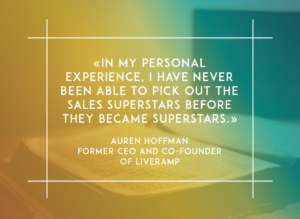
BJ: They walk in the office green or something.
Auren: Exactly.
Male Participant: Great talk. My question is when you’re getting started with picking out who you actually want to connect on either side of the middleware. How’d that play into your initial deal-making process? Figure out which products you actually supported and built your platform around at the beginning?
Auren: Sorry. What do you mean by which products?
Male Participant: If you’re connecting marketing tech products.
Auren: If you’re middleware and you’re connecting products to one another, then you really have to understand what do your customers use. For instance, a lot of you guys probably use Google Apps. If you’re a middleware for a sales organization, pulling data out of Google Apps is probably good.
Probably a lot of you guys use Salesforce. That’s probably a good place. In the marketing tech where we use the number one marketing technology company in the world is Google. That’s probably a good place to start. [laughs] We should probably go with Google.
It’s the best place to go and most of the spend is going through Google. That, to us, was the number one most important place. There’s these core ad networks, core other platforms that are out there. Things like Facebook, and Twitter, and some of these other places that you want to move data in between, as well.
BJ: Maybe one more question.
Male Participant: G’day mate. Just with your sales team, you talked about five people, $21 million. Can you explain the roles of those people and how you would achieve that? Or understand that it was a niche market and you owned the market, but it’s still fascinating to hear five people. How did they handle the deal flow, that kind of stellar growth?
Auren: First of all, remember we went from 1, 9, 21. We had nine in the bank from the year before, and then we were able to upgrade some of that nine. We’re not talking about 21 in new bookings for the year with those five sales people.
Male Participant: $10 million a year’s pretty good.
Auren: The huge problem with most sales people is you don’t have the leads, you don’t have good people to talk to. It’s not like sales conversations for one customer is going to take up a thousand hours a year of your time.
You only have so many emails you can do for follow ups, so many things you can send them, so many meetings. We’re talking about probably 20, 30, 40 hours for a big customer that is going to take that much of your time to go do.
You don’t need a lot of salespeople to do sales. Usually the reason you see a lot of salespeople is either the relationships…If you’re actually taking people out to dinner, you, it takes a long time to build these relationships. You can only maintain so many relationships at once.
Or another reason you might need a lot of salespeople is that they’re unearthing the leads themselves and they’re trying to get these leads themselves. In our case, because we’re a middleware company, most of our leads came from our partners. We had our partners sending us all these leads.
They’re like, “Hey, to use our product better you should go over here. That made it really, really easy and much better. That could be the same if you have a great marketing organization. It could be something similar where you need fewer sales people because you have a great marketing organization.
BJ: That’s our time. Thanks so much.
Auren: Thank you.
BJ: That was great, absolutely.
You can find the slides from Auren’s presentation here.
